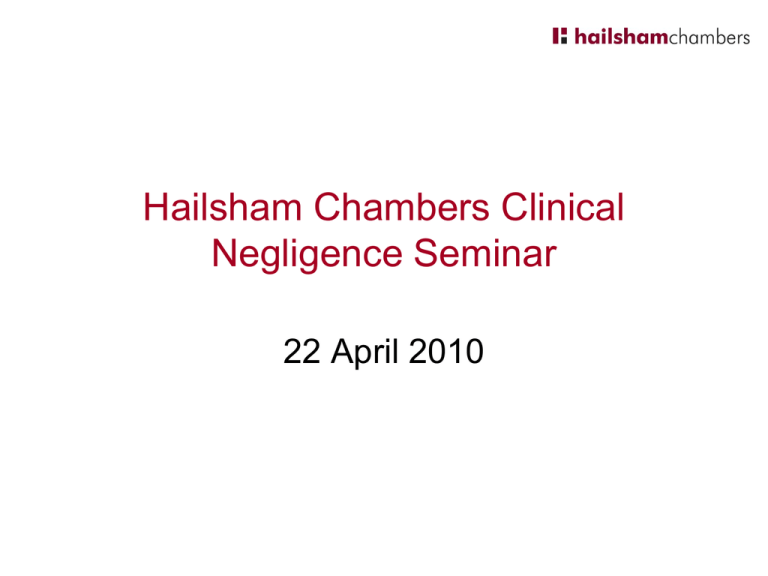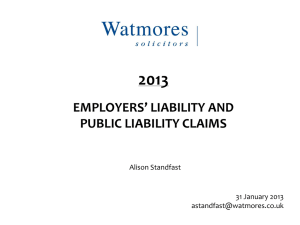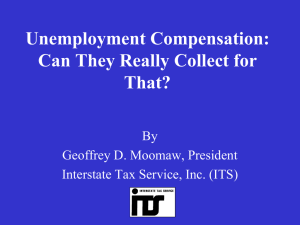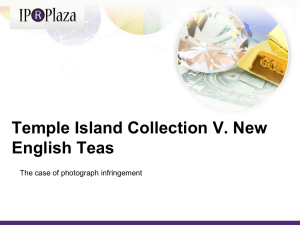Employment Group - Hailsham Chambers
advertisement

Hailsham Chambers Clinical Negligence Seminar 22 April 2010 Clinical Negligence Update By Lucy MacKinnon 3. Roach v The Home Office [2010] 2 WLR 746 • Issue – can costs incurred at an inquest be claimed as part of the costs bill in subsequent litigation? • Facts – Two prisoners who committed suicide by hanging themselves in their prison cells. • Prisons criticised during inquests. Statutory basis S.51 of the Supreme Court Act 1981: (1) Subject to the provisions of this or any other enactment and to rules of court, the costs of and incidental to all proceedings in: a) the civil division of the Court of Appeal; b) the High Court; and c) any county court, shall be within the discretion of the court. Decision • Costs incurred during an inquest can constitute “costs of and incidental to proceedings”. • Any costs claimed can still be challenged on the basis of reasonableness and proportionality. 2. Conan Ingram (A protected party) v Williams [2010] EWHC 758 (QB) • Facts – Alleged failure by GP to conclude that membranes might have ruptured. • Four possible causes of C’s disability: 1. Prematurity; 2. Presence of a urinary tract infection (the cystitis diagnosed by Dr Gareth); 3. Episodes of infection in the neonatal period; 4. Possible infection of the amniotic fluid following premature rupture of the membranes. Bailey v Ministry of Defence [2009] 1 WLR 1052: “I would summarise the position in relation to cumulative cause cases as follows. If the evidence demonstrates on a balance of probabilities that the injury would have occurred as a result of the non−tortious cause or causes in any event, the claimant will have failed to establish that the tortious cause contributed. … If the evidence demonstrates that ‘but for' the contribution of the tortious cause the injury would probably not have occurred, the claimant will (obviously) have discharged the burden. In a case where medical science cannot establish the probability that ‘but for' an act of negligence the injury would not have happened but can establish that the contribution of the negligent cause was more than negligible, the ‘but for‘ test is modified, and the claimant will succeed.” Causation arguments of the Defendant • D argued that he should only be liable to the extent of his material contribution to the injuries. HELD – This was likely to be inconsistent with Bailey. • C’s damage was not indivisible and, therefore, the “but for” test should apply. HELD – This was a possibility but court could not divide up the damage in C’s case. 1. Farraj v King’s Healthcare NHS Trust & Cytogenic DNA Services [2010] Med LR 1 • Facts – C wished for foetal sample to be tested for inherited blood disorder. • Poor quality sample taken. • Sample sent by D1 to D2 for cleaning and culturing. • Returned sample tested leading to erroneous advice that no blood disorder. Decision of the Court of Appeal • D1 owed a duty in tort to provide C with reliable information as to whether the foetus had the blood disease. • D1 entitled to conclude that, if there was doubt about the identity of the sample and whether it came from the mother or the foetus, D2 would either not culture the sample at all or inform D1 of the doubt. • D1 was entitled to assume that the sample was satisfactory unless D2 told them otherwise. Non-delegable duty of care Per Dyson LJ: “…a hospital generally owes a non-delegable duty to its patients to ensure that they are treated with skill and care regardless of the employment status of the person who is treating them…the rationale for this is that the hospital undertakes the care, supervision and control of its patients who are in special need for care. Patients are a vulnerable class of persons who place themselves in the care and under the control of a hospital and, as a result, the hospital assumes a particular responsibility for their well-being and safety.” However, C was not a patient! THE END! Who wins the prize? Roberts v Johnstone Awards Henry Bankes-Jones The Problem • The cost of the necessary alternative accommodation occasioned by the Claimant’s injuries • Versus the Capital Asset acquired in the new accommodation as a corollary of the need for suitable alternative accommodation HISTORICAL DIFFICULTIES & CONFLICTING APPROACHES • George v Pinnock [1973] 1 W.L.R. 118 - Approach of Orr LJ • Wright v British Railways Board [1983] A.C. 773 - Reasoning adopted by Lord Diplock The Solution • Roberts v Johnstone [1989] Q.B. 878 • A combination of the two earlier approaches (I) “The plaintiff is entitled to be compensated to the extent that this loss of income or notional outlay by way of mortgage interest exceeds what the cost of her accommodation would have been but for the accident” (II) “appropriate to consider the annual cost in terms of lost income and investment, since the sum yielded would not be available to produce income. A Tax free yield of 2% in risk free investment would not be a wholly inappropriate one” Formula to be applied Extra cost of the new property, taking into account the sum realised in the sale of the former property, if appropriate, say £100,000 less £60,000 from the sale of the former property = £40,000 X 2.5% (the applicable discount rate, as now set) X agreed life multiplier of, (for example), 10 = £10,000 Clearly, must still have Medical Evidence showing the need for the Property • Cunningham v Harrison [1973] Q.B. 942, CA • Burton v Kingsbury [2007] 2091 (QB) (Flaux J) • Cassel v Riverside Health Authority [1992] P.I.Q.R. Q168, CA (Civ Div) Additional Expenses also Included • Cost of Adaption • Costs of Moving House • Potential Additional Costs Associated with the New Accommodation Solutions to problems within the scope of Roberts v Johnstone • Analysis in Iqbal v Whipps Cross University Hospital NHS Trust [2006] EWHC 3111 (QB) • Lewis v Royal Shrewsbury Hospital NHS Trust QBD (Birmingham) (Alasitair Macduff )29/01/07 • Noble v Owens [2008] EWHC 359 • Willett v North Bedfordshire HA [1993] P.I.Q.R. Q 166 More Recent Developments • Proposals for a Claimant to be given a charge over the Property redeemable on the Claimant’s death • Ryan St George v The Home Office [2008] EWCA Civ 1068 McKay J agreed that the Claimant should rent a suitable property to be paid for by way of periodical payments linked to the RPI HOWEVER.......... • “In all other respects, Roberts & Johnstone formula is unchanged and remains good law” per HHJ Macduff, in Lewis • Possible future solutions? Psychiatric Injury James Gilberthorpe Primary & Secondary Victims • Different rules apply concerning recovery of damages. • Artificial control mechanisms applied by the judiciary to make recovery more difficult for secondary victims. Primary victims • Lord Oliver in Alcock v Chief Constable of South Yorks Police 1992 1 AC 310: “Cases in which damages are claimed for directly inflicted injuries of this nature may present greater difficulties of proof but they are not, in their essential elements, any different from cases where the damages claimed arise from direct physical injury and they present no very difficult problems of analysis where the plaintiff has himself been directly involved in the accident from which the injury is said to arise. In such a case he can be properly said to be the primary victim of the defendant's negligence and the fact that the injury which he sustains is inflicted through the medium of an assault on the nerves or senses does not serve to differentiate the case, except possibly in the degree of evidentiary difficulty, from a case of direct physical injury.” Control mechanisms for secondary victims • McLoughlin v O’Brian [1983] 1 AC 410 – Secondary victims must satisfy the following “control mechanisms”: (1)Close ties of love and affection; (2)Proximity to the accident or its immediate aftermath; (3)Direct perception by sight or hearing Approval of the “control mechanisms” for secondary victims • Alcock v Chief Constable of South Yorkshire Police [1992] 1 A.C. 310 – Two classes of victim: (a)Primary victim – those directly involved in the accident; need only show physical injury was reasonably foreseeable. (b) Secondary victim – those not personally threatened or directly involved; claims subject to control mechanisms. Secondary victims • Simple test of foreseeability unanimously rejected in favour of the control mechanisms. (1)Close ties of love and affection: • Not limited to family relationships but other relationships would be subject to scrutiny. • Evidence of “love and affection required”. Secondary victims (2) Proximity to the accident / the immediate aftermath: • “the sudden appreciation by sight or sound of a horrifying event which violently agitated the mind. It has yet to include the psychiatric illness caused by the accumulation over a period of time of more gradual assaults on the nervous system”. • ‘Immediate aftermath’ - 8 hours too long, 2 hours “on the margin”. • Psychiatric illness caused by the shock of witnessing the accident or the immediate aftermath. Secondary victims (3) Direct perception by sight or hearing • Television broadcasts not, in this case, “sight or hearing”. • Lord Ackner: “Although the television pictures gave rise to feelings of the deepest anxiety and distress, in the circumstances of this case the simultaneous television broadcasts of what occurred cannot be equated with “sight or hearing of the event or its immediate aftermath.” Accordingly, shocks sustained by reason of these broadcasts cannot found a claim.” Egg shell personality • Page v Smith [1996] 1 A.C. 155: • Primary victims - includes those with an “egg shell personality” and only need establish that physical injury was reasonably foreseeable. Psychiatric injury does not need to be reasonably foreseeable. • Secondary victims – recovery only if defendant could have foreseen psychological injury to a person of ordinary fortitude. (Forth control). Summary • PRIMARY VICTIM: • SECONDARY VICTIM • Directly involved in accident / event. • Includes rescuers who put themselves in danger or reasonably perceive themselves to be in danger. • Sufficient that physical injury was reasonably foreseeable, even if psychiatric injury was not. • Not personally threatened or directly involved. Close ties of love and affection; Proximity to accident / immediate aftermath; Direct perception by sight or hearing. Foreseeable that a person of reasonable fortitude could suffer from a psychiatric illness. (1) (2) (3) (4) Walters v North Glamorgan NHS Trust [2002] EWCA CIV 1792 • Defendant accepted it had been negligent in its failure to diagnose acute hepatitis. • Mother asleep next to 10 month old son, Elliot, in hospital room. • Awoke to sound of Elliot choking and covered with dried blood. Mother takes Elliot to nurse. • Elliot had had an epileptic fit and parents initially told incorrectly that brain damage was very unlikely. • Elliot transferred to another hospital by ambulance with parents following behind in car. • Upon arrival parents informed that Elliot had suffered severe brain damage. • Elliot placed on a life support machine that was turned off with Elliot dying in mother’s arms. • Whole “event” lasting 36 hours. Ward v Leeds Teaching Hospitals NHS Trust • Claimant mother of 22 year old daughter still living at home. • Daughter in hospital to have her wisdom teeth removed. • Liability admitted for daughter’s death. • Daughter never woke up after the wisdom teeth had been removed under general anesthetic. Ward v Leeds Teaching Hospitals NHS Trust • Mum asked to telephone hospital at 4pm, did as told, Katherine not out of recovery. • Mum goes to hospital and told Katherine still not out of recovery. • Doctor tells mum that Katherine does not appear to be able to come round. • Mum sees Katherine who was breathing by herself and “looked as though she was asleep.” • Mum remains with Katherine all night and next morning is informed by Dr to prepare for worse. • Organ donation declined and mum declines to be present when ventilator switched off. • Mum visits Katherine in mortuary. Froggatt, Froggatt, Dale Gale v Chesterfield NHS Trust 2002 • Mrs Froggatt negligently diagnosed as having breast cancer. • Underwent mastectomy and extensive reconstructive surgery resulting in significant cosmetic deformity and psychological injury. • Husband upon first seeing his wife undressed after mastectomy said “…It did my head in. She looked just like a man.” • Dale overheard his mother on the phone and he immediately came to her crying and asking her if she was going to die. Farrell v Avon Health Authority • Claimant father receives call from mother telling him he is a father, no mention of any problems. • Excitedly Claimant rushes to hospital to see his son and is taken to a side room. • Nurse tells Claimant that his son died an hour ago. • Claimant given a dead baby to hold, which turns out not to be his son. • Only later does he see his own son and the mother for 5 minutes before running out to be sick. Compare/Contrast • Tredget & Tredget v Bexley Health Authority • [1994] 5 Med LR 178 • Tan v East London Health Authority • [1999] Lloyd’s Rep. Med 389 Final Pointers • • • • Each case is fact and expert evidence specific. Know your case law. Know what you need your expert to say. What is the other side’s expert report not saying? • Make sure your witness statement is “shocking.” • Bear in mind Judges may be becoming more liberal with the “control mechanisms.” Psychiatric Injury Presented by James Gilberthorpe








